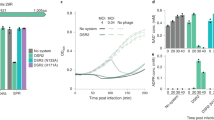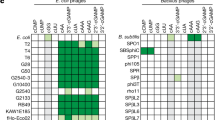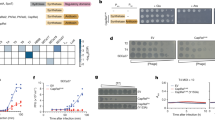Abstract
CRISPR–Cas systems are adaptive immune systems that protect bacteria from bacteriophage (phage) infection1. To provide immunity, RNA-guided protein surveillance complexes recognize foreign nucleic acids, triggering their destruction by Cas nucleases2. While the essential requirements for immune activity are well understood, the physiological cues that regulate CRISPR–Cas expression are not. Here, a forward genetic screen identifies a two-component system (KinB–AlgB), previously characterized in the regulation of Pseudomonas aeruginosa alginate biosynthesis3,4, as a regulator of the expression and activity of the P. aeruginosa Type I-F CRISPR–Cas system. Downstream of KinB–AlgB, activators of alginate production AlgU (a σE orthologue) and AlgR repress CRISPR–Cas activity during planktonic and surface-associated growth5. AmrZ, another alginate regulator6, is triggered to repress CRISPR–Cas immunity upon surface association. Pseudomonas phages and plasmids have taken advantage of this regulatory scheme and carry hijacked homologs of AmrZ that repress CRISPR–Cas expression and activity. This suggests that while CRISPR–Cas regulation may be important to limit self-toxicity, endogenous repressive pathways represent a vulnerability for parasite manipulation.
This is a preview of subscription content, access via your institution
Access options
Access Nature and 54 other Nature Portfolio journals
Get Nature+, our best-value online-access subscription
$29.99 / 30 days
cancel any time
Subscribe to this journal
Receive 12 digital issues and online access to articles
$119.00 per year
only $9.92 per issue
Buy this article
- Purchase on Springer Link
- Instant access to full article PDF
Prices may be subject to local taxes which are calculated during checkout




Similar content being viewed by others
Data availability
Source data and statistics used to generate figures are provided with the paper. Additional data supporting the findings of this paper are available from the corresponding author on request.
References
Barrangou, R. et al. CRISPR provides acquired resistance against viruses in prokaryotes. Science 315, 1709–1712 (2007).
Brouns, S. J. J. et al. Small CRISPR RNAs guide antiviral defense in prokaryotes. Science 321, 960–964 (2008).
Damron, F. H., Qiu, D. & Yu, H. D. The Pseudomonas aeruginosa sensor kinase KinB negatively controls alginate production through AlgW-dependent MucA proteolysis. J. Bacteriol. 191, 2285–2295 (2009).
Damron, F. H. et al. Analysis of the Pseudomonas aeruginosa regulon controlled by the sensor kinase KinB and sigma factor RpoN. J. Bacteriol. 194, 1317–1330 (2012).
Wozniak, D. J. & Ohman, D. E. Transcriptional analysis of the Pseudomonas aeruginosa genes algR, algB, and algD reveals a hierarchy of alginate gene expression which is modulated by algT. J. Bacteriol. 176, 6007–6014 (1994).
Baynham, P. J. & Wozniak, D. J. Identification and characterization of AlgZ, an AlgT-dependent DNA-binding protein required for Pseudomonas aeruginosa algD transcription. Mol. Microbiol. 22, 97–108 (1996).
Hochstrasser, M. L. et al. CasA mediates Cas3-catalyzed target degradation during CRISPR RNA-guided interference. Proc. Natl Acad. Sci. USA 111, 6618–6623 (2014).
Westra, E. R. et al. CRISPR immunity relies on the consecutive binding and degradation of negatively supercoiled invader DNA by Cascade and Cas3. Mol. Cell 46, 595–605 (2012).
Levy, A. et al. CRISPR adaptation biases explain preference for acquisition of foreign DNA. Nature 520, 505–510 (2015).
Haurwitz, R. E., Jinek, M., Wiedenheft, B., Zhou, K. & Doudna, J. A. Sequence- and structure-specific RNA processing by a CRISPR endonuclease. Science 329, 1355–1358 (2010).
Wiedenheft, B. et al. Structural basis for DNase activity of a conserved protein implicated in CRISPR-mediated genome defense. Structure 17, 904–912 (2009).
Wiedenheft, B. et al. RNA-guided complex from a bacterial immune system enhances target recognition through seed sequence interactions. Proc. Natl Acad. Sci. USA 108, 10092–10097 (2011).
Rollins, M. F., Schuman, J. T., Paulus, K., Bukhari, H. S. T. & Wiedenheft, B. Mechanism of foreign DNA recognition by a CRISPR RNA-guided surveillance complex from Pseudomonas aeruginosa. Nucleic Acids Res. 43, 2216–2222 (2015).
Rollins, M. F. et al. Cas1 and the Csy complex are opposing regulators of Cas2/3 nuclease activity. Proc. Natl Acad. Sci. USA 114, E5113–E5121 (2017).
Chowdhury, S. et al. Structure reveals mechanisms of viral suppressors that intercept a CRISPR RNA-guided surveillance complex. Cell 169, 47–57 (2017).
Zegans, M. E. et al. Interaction between bacteriophage DMS3 and host CRISPR region inhibits group behaviors of Pseudomonas aeruginosa. J. Bacteriol. 191, 210–219 (2009).
Cady, K. C. & O’Toole, G. A. Non-identity-mediated CRISPR-bacteriophage interaction mediated via the Csy and Cas3 proteins. J. Bacteriol. 193, 3433–3445 (2011).
Cady, K. C., Bondy-Denomy, J., Heussler, G. E., Davidson, A. R. & O’Toole, G. A. The CRISPR/Cas adaptive immune system of Pseudomonas aeruginosa mediates resistance to naturally occurring and engineered phages. J. Bacteriol. 194, 5728–5738 (2012).
Vorontsova, D. et al. Foreign DNA acquisition by the I-F CRISPR–Cas system requires all components of the interference machinery. Nucleic Acids Res. 43, 10848–10860 (2015).
van Belkum, A. et al. Phylogenetic distribution of CRISPR-Cas systems in antibiotic-resistant Pseudomonas aeruginosa. mBio 6, e01796-15 (2015).
Westra, E. R. et al. Parasite exposure drives selective evolution of constitutive versus inducible defense. Curr. Biol. 25, 1043–1049 (2015).
van Houte, S. et al. The diversity-generating benefits of a prokaryotic adaptive immune system. Nature 532, 385–388 (2016).
Bondy-Denomy, J., Pawluk, A., Maxwell, K. L. & Davidson, A. R. Bacteriophage genes that inactivate the CRISPR/Cas bacterial immune system. Nature 493, 429–432 (2013).
Pawluk, A., Bondy-Denomy, J., Cheung, V. H. W., Maxwell, K. L. & Davidson, A. R. A new group of phage anti-CRISPR genes inhibits the type I-E CRISPR-Cas system of Pseudomonas aeruginosa. mBio 5, e00896-14 (2014).
Bondy-Denomy, J. et al. Multiple mechanisms for CRISPR–Cas inhibition by anti-CRISPR proteins. Nature 526, 136–139 (2015).
Pawluk, A. et al. Inactivation of CRISPR-Cas systems by anti-CRISPR proteins in diverse bacterial species. Nat. Microbiol. 1, 16085 (2016).
Høyland-Kroghsbo, N. M. et al. Quorum sensing controls the Pseudomonas aeruginosa CRISPR-Cas adaptive immune system. Proc. Natl Acad. Sci. USA 114, 131–135 (2016).
Patterson, A. G. et al. Quorum sensing controls adaptive immunity through the regulation of multiple CRISPR-Cas systems. Mol. Cell 64, 1102–1108 (2016).
Borges, A. L. et al. Bacteriophage cooperation suppresses CRISPR-Cas3 and Cas9 immunity. Cell 174, 917–925 (2018).
Chand, N. S. et al. The sensor kinase KinB regulates virulence in acute Pseudomonas aeruginosa infection. J. Bacteriol. 193, 2989–2999 (2011).
Chand, N. S., Clatworthy, A. E. & Hung, D. T. The two-component sensor KinB acts as a phosphatase to regulate Pseudomonas aeruginosa virulence. J. Bacteriol. 194, 6537–6547 (2012).
Cezairliyan, B. O. & Sauer, R. T. Control of Pseudomonas aeruginosa AlgW protease cleavage of MucA by peptide signals and MucB. Mol. Microbiol. 72, 368–379 (2009).
Schurr, M. J., Yu, H., Martinez-Salazar, J. M., Boucher, J. C. & Deretic, V. Control of AlgU, a member of the sigma E-like family of stress sigma factors, by the negative regulators MucA and MucB and Pseudomonas aeruginosa conversion to mucoidy in cystic fibrosis. J. Bacteriol. 178, 4997–5004 (1996).
Tart, A. H., Blanks, M. J. & Wozniak, D. J. The AlgT-dependent transcriptional regulator AmrZ (AlgZ) inhibits flagellum biosynthesis in mucoid, nonmotile Pseudomonas aeruginosa cystic fibrosis isolates. J. Bacteriol. 188, 6483–6489 (2006).
Schulz, S. et al. Elucidation of sigma factor-associated networks in Pseudomonas aeruginosa reveals a modular architecture with limited and function-specific crosstalk. PLoS Pathog. 11, e1004744 (2015).
Wozniak, D. J. et al. Alginate is not a significant component of the extracellular polysaccharide matrix of PA14 and PAO1 Pseudomonas aeruginosa biofilms. Proc. Natl Acad. Sci. USA 100, 7907–7912 (2003).
Pratama, A. A. & van Elsas, J. D. A novel inducible prophage from the mycosphere inhabitant Paraburkholderia terrae BS437. Sci. Rep. 7, 9156 (2017).
Pryor, E. E. et al. The transcription factor AmrZ utilizes multiple DNA binding modes to recognize activator and repressor sequences of Pseudomonas aeruginosa virulence genes. PLoS Pathog. 8, e1002648 (2012).
Martin, D. W. et al. Mechanism of conversion to mucoidy in Pseudomonas aeruginosa infecting cystic fibrosis patients. Proc. Natl Acad. Sci. USA 90, 8377–8381 (1993).
Jones, A. K. et al. Activation of the Pseudomonas aeruginosa AlgU regulon through mucA mutation inhibits cyclic AMP/Vfr signaling. J. Bacteriol. 192, 5709–5717 (2010).
Koonin, E. V. & Makarova, K. S. Mobile genetic elements and evolution of CRISPR-Cas systems: all the way there and back. Genome Biol. Evol. 9, 2812–2825 (2017).
Heilmann, S., Sneppen, K. & Krishna, S. Sustainability of virulence in a phage-bacterial ecosystem. J. Virol. 84, 3016–3022 (2010).
Dötsch, A. et al. The Pseudomonas aeruginosa transcriptional landscape is shaped by environmental heterogeneity and genetic variation. mBio 6, e00749–15 (2015).
Erdmann, J., Preusse, M., Khaledi, A., Pich, A. & Häussler, S. Environment-driven changes of mRNA and protein levels in Pseudomonas aeruginosa. Environ. Microbiol. 20, 3952–3963 (2018).
Smale, S. T. β-galactosidase assay. Cold Spring Harb. Protoc. https://doi.org/10.1101/pdb.prot5423 (2010).
Altschul, S. F., Gish, W., Miller, W., Myers, E. W. & Lipman, D. J. Basic local alignment search tool. J. Mol. Biol. 215, 403–410 (1990).
Sievers, F. et al. Fast, scalable generation of high-quality protein multiple sequence alignments using Clustal Omega. Mol. Syst. Biol. 7, 539 (2011).
Waterhouse, A. M., Procter, J. B., Martin, D. M. A., Clamp, M. & Barton, G. Jalview Version 2—a multiple sequence alignment editor and analysis workbench. Bioinformatics 25, 1189–1191 (2009).
Arndt, D. et al. PHASTER: a better, faster version of the PHAST phage search tool. Nucleic Acids Res. 44, W16–W21 (2016).
Acknowledgements
We thank D. Hung’s lab for providing ∆kinB, ∆algB, ∆algR and ∆algU mutants and G. O’Toole’s lab for providing the csy3::lacZ PA14 strain. We thank K. Trotta (S. Chou’s lab, UCSF) for advice in the development of fluorescent assays and A. Santiago-Frangos (B. Wiedenheft’s lab, MSU) for advice and consultation. J.B.-D.’s lab was supported by the UCSF Program for Breakthrough in Biomedical Research (funded in part by the Sandler Foundation), the Innovative Genomics Institute, a National Institutes of Health Office of the Director Early Independence Award (no. DP5-OD021344) and grant no. R01GM127489.
Author information
Authors and Affiliations
Contributions
J.B.-D., A.L.B. and B.C. formulated the study design and plans. A.L.B. performed CRISPR–Cas activity and expression profiling and conducted bioinformatics analyses. B.C. conducted the genetic screen and constructed and characterized bacterial mutants. S.G. constructed sfCherry reporter strains. T.S. conducted CRISPRi assays. V.E. assisted in establishing reporter assays. J.B.-D. and A.L.B wrote the manuscript.
Corresponding author
Ethics declarations
Competing interests
J.B.-D. is a scientific advisory board member of SNIPR Biome and Excision Biotherapeutics and a scientific advisory board member and cofounder of Acrigen Biosciences.
Additional information
Publisher’s note Springer Nature remains neutral with regard to jurisdictional claims in published maps and institutional affiliations.
Extended data
Extended Data Fig. 1 Mapped insertions from transposon mutagenesis screen.
All independent transposon insertions identified and mapped by visual screening with increased or decreased csy3::lacZ β-galactosidase activity. β-galactosidase activity is expressed as a percentage of the unmutagenized parent strain, and measurements were taken at a single timepoint after 8 h of growth in liquid culture. The insertion location in the PA14 genome is shown, along with the measured level of β-galactosidase enzyme at the 8 hour timepoint. These measurements were not determined (N/D) for strains with a growth defect.
Extended Data Fig. 2 Characterization of kinB::Tn mutants.
a. A streak plate on X-gal plates, showing strains involved in this study and isolated transposon (Tn) insertions. csy3::lacZ is a derivative of WT PA14, and is the unmutagenized parent of kinB::Tn 1-3. b. β-galactosidase measurements of strains grown in liquid culture for the indicuated time. Measurements for the unmutagenized (csy3::lacZ) parent strain and three isolated kinB transposon mutants (kinB::Tn1-3) are shown, as well as a control PA14 culture with no lacZ insertion. c. Phage titration on lawns of the kinB::Tn1 mutant transformed with empty vector or kinB. d. Spot titration of phages JBD26 (CR2_sp17, sp20-targeted, possessing acrIF4), JBD25 (CR1_sp1 targeted) on kinB::Tn mutants and ∆CRISPR-Cas. These experiments have been replicated at least 2 times with consistent results.
Extended Data Fig. 3 Double knockouts of pathway members.
a, b. Efficiency of immunity measurements for indicated mutants relative to WT. a. Double knockouts show ∆kinB combined with algB, algU, algR, or amrZ. EOI measurements are shown as the mean of 3 biological replicates, ± S.D. Mutants show increased EOI against DMS3macrIF4 relative to WT (∆kinB∆algB, P = 3.8 x 10-2, ∆kinB∆algU, P = 5.9 x 10-3, ∆kinB∆algR, P = 1.5 x 10-2, ∆kinB∆amrZ, P = 3.2 x 10-3) Two-tailed unpaired Student’s T-test was used to calculate P value, *p < 0.05, **p < 0.01. b. Indicated knockouts were combined with csy3::lacZ, EOI shown as the mean of two biological replicates.. These experiments have been replicated at least 2 times with consistent results.
Extended Data Fig. 4 AmrZ activity in liquid growth.
a. qRT-PCR measurements of transcript levels of csy3 (light grey) and cas3 (dark grey) normalized to the housekeeping gene rpsL after 8 h of growth in liquid culture. Measurements are represented as the mean of 3 technical replicates. b. Measurement of the fluorescence levels of Csy1-sfCherry (light grey) or Cas3-sfCherry (dark grey) reporter strains after 10 h of growth in liquid culture. Fluorescence measurements are represented as the mean of 3 biological replicates +/- SD. Cas3-sfCherry (P = 0.26) and Csy1-sfCherry levels (P = 0.35) in ∆amrZ did not differ significantly from WT. Two-tailed unpaired Student’s T-test was used to calculate P value, ns = not significant c. csy3::lacZ β-galactosidase activity from PA14 WT csy3::lacZ transformed with either empty vector (EV) or a plasmid overexpressing AmrZ (+AmrZ). β-galactosidase reporter activity was measured after 8 h in liquid growth and is represented as the mean of 3 technical replicates. Experiment was replicated two times with consistent results.
Extended Data Fig. 5 Mobile AmrZ homologs.
AmrZ homologs listed by the genome that encodes them, the accession number, and the mobile genetic element type.
Extended Data Fig. 6 AmrZ copy number analysis of two Pseudomonas aeruginosa strains.
AmrZ copy number analysis of two different strains of Pseudomonas aeruginosa. AmrZ homologs listed by accession number and their genomic coordinates. Phaster49 was used to identify the prophages encoding mobile AmrZ copies.
Extended Data Fig. 7 Cas and Csy RNA and protein levels across growth conditions.
Supplementary Information
Supplementary Table 1
Strains, plasmids and primers.
Source data
Source Data Fig. 1
Statistical source data.
Source Data Fig. 2
Statistical source data.
Source Data Fig. 3
Statistical source data.
Source Data Fig. 4
Statistical source data.
Source Data Extended Data Fig. 3
Statistical source data.
Source Data Extended Data Fig. 4
Statistical source data.
Source Data Extended Data Fig. 7
Statistical source data.
Rights and permissions
About this article
Cite this article
Borges, A.L., Castro, B., Govindarajan, S. et al. Bacterial alginate regulators and phage homologs repress CRISPR–Cas immunity. Nat Microbiol 5, 679–687 (2020). https://doi.org/10.1038/s41564-020-0691-3
Received:
Accepted:
Published:
Issue Date:
DOI: https://doi.org/10.1038/s41564-020-0691-3
This article is cited by
-
Inhibitors of bacterial immune systems: discovery, mechanisms and applications
Nature Reviews Genetics (2024)
-
Biomimetic natural biomaterials for tissue engineering and regenerative medicine: new biosynthesis methods, recent advances, and emerging applications
Military Medical Research (2023)
-
Engineered CRISPR-Cas systems for the detection and control of antibiotic-resistant infections
Journal of Nanobiotechnology (2021)
-
A histidine kinase and a response regulator provide phage resistance to Marinomonas mediterranea via CRISPR-Cas regulation
Scientific Reports (2021)
-
Controlling and enhancing CRISPR systems
Nature Chemical Biology (2021)



